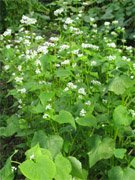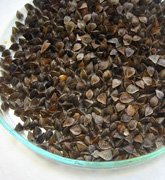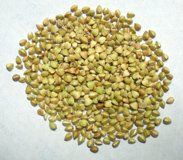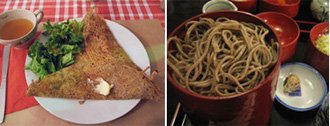Buckwheat Nutrition facts
Buckwheat is neither a cereal grain nor related to wheat. It is, in fact, a dicotyledon seed but treated in a similar way as any other common cereal grain.
Binomially, it belongs to the family of Polygonaceae, which also includes sorrel, rhubarb, Japanese knotweed, etc. The Scientific name is Fagopyrum esculentum.

|

|
| Common Buckwheat- Fagopyrum esculentum.Note for broad triangular leaves and white flowers in clusters. Photo courtesy: Garden girl | Unhulled buckwheat seeds (grains). Note for dark brown color pyramidal shaped seeds with round basal ends. Photo courtesy: Dag Endresen |
Buckwheat crop was first cultivated in the high plains of southeastern China and the Himalayas centuries ago, where it was the staple food of the inhabitants, much before rice and other cereal grains gradually replaced its cultivation.
Buckwheat crop provided much-needed essential nutrients, protein, fats, and minerals to the local inhabitants during early civilization times, enabling them to thrive well under inhospitable terrains. Lately, a renewed interest is growing in its revival as a mainstream crop among food and nutrition scientists.
Common buckwheat, much similar to quinoa, is not a novel cereal grain as one might think, but just an old crop. It is a short-season, dicotyledon (like pulses/beans) crop and cultivated as an annual, flowering herb, which grows well even under less than optimum soil and moisture conditions. Frost, however, could prove detrimental to its survival.
The plant reaches about 45-60 cm in height with branches and produces pink or white flowers in clusters that attract honeybees.
The buckwheat seed features a three-sided pyramidal shape, brown to gray, with a thick outer hull. Inside, the seed kernel is cream white and has a nutty flavor.
Buckwheat's well-balanced starch, protein, fat, and mineral composition have found a renewed interest, particularly among food scientists. Additionally, its seeds compose proportionately more starch and less fat than fellow oil seeds and hence, are treated in a similar way as any other staple grains.
Being a short-season crop and sustainable characteristic of thriving under drought conditions, it can be an answer for malnutrition alleviation programs, particularly in regions where famine is common.
8 amazing Health benefits of Buckwheat
Buckwheat grains compose proportionately more starch than other similar seeds like quinoa and amaranth. 100 g seeds (grains) provide 343 calories. Its grains are moderate sources of energy. The calorie content of ts seeds may be compared to that of major cereals such as wheat, maize, rice and that of pulses like chickpea, mung bean, cowpea (black-eyed pea), etc.
The protein level in buckwheat grains is in the range of 11-14 g per 100 g; relatively less than that in quinoa and pulses. Nonetheless, it composes almost all of the essential amino acids at the right proportions, especially lysine which otherwise is a limiting amino acid in grains like wheat, maize, rice, etc.
Buckwheat seeds are a very rich source of soluble and insoluble dietary fiber. 100 g provides 10 g or 26% of the daily requirement of fiber. Fiber increases the bulk of the food and helps prevent constipation problems by speeding up bowel movements through the gut. Fiber also binds to toxins and aid in their excretion through the gut and, thereby help protect colon mucosa from cancers.
Also, dietary fibers bind to bile salts (produced from cholesterol) and decrease their re-absorption in the colon, thus helping lower serum LDL-cholesterol levels.
Buckwheat is another gluten-free food source. Gluten is a protein present in certain grass (wheat) family grains and may induce stomach upset and diarrhea in individuals with Celiac disease.
The grains compose of several polyphenolic antioxidant compounds such as rutin, tannins, and catechin. Rutin (quercetin rutinoside) is found to have anti-inflammatory, and antioxidant properties and help prevent platelet clot formation inside the blood vessels. Early laboratory studies suggest that rutin may offer a cure in hemorrhoids and clotting disorders.
Buckwheat grains have more B-complex group of vitamins than that of quinoa seeds, especially riboflavin (vitamin B2) and niacin (vitamin B3).
Finally, buckwheat has more concentration of minerals like copper, and magnesium. Copper is required for the production of red blood cells. Magnesium relaxes blood vessels leading to the brain and is found to have healing effects on depression and headaches.
| Principle | Nutrient Value | Percent of RDA |
|---|---|---|
| Energy | 343 Kcal | 17% |
| Carbohydrates | 71.50 g | 55% |
| Protein | 13.25 g | 24% |
| Total Fat | 3.40 g | 17% |
| Cholesterol | 0 mg | 0% |
| Dietary Fiber | 10 g | 26% |
| Vitamins | ||
| Folates (B9) | 30 µg | 7.5% |
| Niacin (B3) | 7.020 mg | 44% |
| Pantothenic acid | 1.233 mg | 25% |
| Riboflavin (B2) | 0.425 mg | 33% |
| Thiamin (B1) | 0.101 mg | 8.5% |
| Vitamin A | 0 IU | 0% |
| Electrolytes | ||
| Sodium | 1 mg | <1% |
| Potassium | 460 mg | 10% |
| Minerals | ||
| Calcium | 18 mg | 2% |
| Copper | 1.100 mg | 122% |
| Iron | 2.20 mg | 27.5% |
| Magnesium | 231 mg | 58% |
| Manganese | 1.300 mg | 56.5% |
| Phosphorus | 347 mg | 50% |
| Selenium | 8.3 µg | 15% |
| Zinc | 2.40 mg | 22% |
| Amino acids | ||
| Lysine | 672 mg | 32% |
| Methionine | 172 mg | 24% |
| Tryptophan | 192 mg | 69% |
Selection and storage

|
| Buckwheat grains-hulled |
Buckwheat grains, groats, and flour can be readily available in markets across the USA. One may find pre-packed, whole hulled seeds, toasted, parboiled, and dried groats on the shelves in these stores. Choose packed, hulled, and toasted groats for immediate use. Unhulled seeds have a thick brown-black outer covering. Hulling exposes off-white color kernels (edible portion) inside.
Buckwheat flour should be bought keeping in mind that it should be used within short notice of time since, being oil-rich, it tends to turn rancid early if stored for extended periods.
At home, store whole groats and grains inside an airtight container in a cool, dry place where they stay fresh for a couple of months. Its flour, however, should be stored inside an air-seal container and kept in the refrigerator.
Preparation and serving methods
Unprocessed buckwheat grain has a thick outer coat (hull). However, it may not entirely be removed, and indeed, eaten as part of food that is rich in dietary fiber.
At home, wash buckwheat groats in cold water as you do it for other cereal grains like rice before cooking. Its groats are cooked in a similar fashion as other staples like rice, oats, bulgur, barley, etc. Roughly, one cup of dry grain cooks to two cups of cooked fluffy and chewy buckwheat.
Here are some serving tips:
 |
| Buckwheat crepes. (Photo: Neil Conway) and Soba noodles (Photo: mari) |
Buckwheat groat has been used as the chief food source among highland Himalayan regions. In other parts around the world, however, it is consumed next to other prominent staples such as wheat, rice, etc. As in quinoa, its flour is mixed with other cereals flours such as millets, maize, wheat, barley, etc., in order to enrich the overall protein quality of the meal, compensating for limiting amino acid levels in cereals.
Soba is the Japanese name for buckwheat. Its flour, alone or mixed with wheat flour, is one of the chief ingredients in the preparation of thin soba noodles.
In Eastern European regions, cooked buckwheat groats are eaten as a portion of favorite filling food. Kasha, toasted buckwheat groats, is a favorite food item akin to couscous in the Middle-east and northern Africa, eaten either alone or with seasonal vegetables and meat in many parts of this region.
In the rest of the world, the grains are used in a number of ways like any other cereal grains to make pilaf, polenta, porridge, flakes, puddings, etc.
Its flour may be used in numerous methods to prepare pancakes, bread, bun, cake, pasta, noodles, cookies, biscuits, etc. In the Northern Indian region; its flour, popular as kuttu, is used to make deep-fried pancakes (kuttu ki poori) and eaten when other cereal grains are abstained from eating during the special religious occasions.
Safety profile
Buckwheat hull and seed kernel compose of polyphenolic flavonoid compound rutin (quercetin rutinoside) in small quantities. Rutin has been found to have anti-inflammatory, antioxidant, and anti-platelet aggregation (blood thinner) functions, in experimental models and may interact with routine medications. (Medical disclaimer).
You may also like to read-
≻≻- Pseudocereals for complete illustrations of their nutrition facts and health benefits.
≻≻-Back to Nuts and seeds from Buckwheat. Visit here for an impressive list of nuts with complete illustrations of their nutrition facts and health benefits.
≻≻-Back to Home page.
Further Resources: